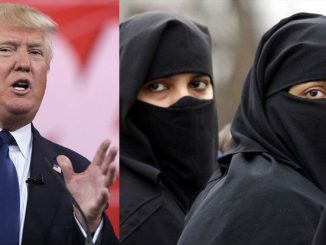The Canadian Federal Election of 2015 was haunted by a spurious debate over a piece of clothing worn by a tiny number of Muslim women in Canada.
Zunera Ishaq, a 29 year-old educator originally from Pakistan, inadvertently sparked a bewilderingly persistent national debate when her refusal to take off her niqab during the citizenship oath caught the attention of politicians, and subsequently, of everyone else.
But to pin the Canadian niqab obsession on Ishaq is disingenuous, for the mainstream media did precious little to clear the air; and when we look closely, not only is the debate’s resilience unsurprising, but also incriminating of the Canadian media.
Curious paradox
Firstly, let’s put all the relevant facts on the table. One fact that news media seemed to selectively report is that every applicant for Canadian citizenship, niqab wearing or otherwise, is extensively vetted and processed with exactly the onslaught of paperwork and bureaucracy you’d expect.
Not to let facts get in the way, that irksome survey—the one saying that 82 per cent of Canadians support a ban on niqabs during the citizenship oath—showed people’s primary concerns about the niqab were around security and identification. A curious paradox, no? Clearly, the survey was either misleading or people were otherwise misinformed. Probably both.
Here’s another fact: PMO advisor Lynton Crosby’s wedge politicking has turned progressives against one another again and again in Australia and the UK. A cynical observer of the polls didn’t miss that, in an encore performance of Crosby’s past designs, the once front-running NDP slipped to a distant third after losing much favour in Quebec—which happened right around the time the question of Ishaq’s attire was gaining momentum.
And you can hardly call Zunera Ishaq representative: the number of other applicants for Canadian citizenship who wanted to wear their niqabs while taking the oath amounts to roughly…two women.
Ultimately, it’s hard to imagine how any thinking person can deny that the niqab-security argument was not only false, but deliberately manipulative. In fact, Calgary mayor Naheed Nenshi says that whenever he explained these things to anti-niqab people one-on-one, they all changed their minds. The plain truth yields a one-hundred percent conversion rate.
Distracted by the distraction
Now, as the politicians love to say, let’s be very clear: it’s not that Canadian media were blind or dumb to these facts. Rather, throughout Election 42, our mainstream giants bequeathed to us column after column calling out the niqab debate as a distraction: from the Globe editorial, from Susan Delacourt in the Toronto Star, from Rex Murphy on CBC television, and even from right-wing darling (eleventh hour apostasy notwithstanding) Andrew Coyne, who penned at least two damning editorials on the topic.
Nonetheless, these same outlets eagerly reported every niqab related story as it developed. Perhaps dutifully so; one might argue that if it’s news, it’s news. What’s confusing is this juxtaposition: the overwhelming opinion column consensus that the debate was a big, racist distraction versus the news columns’ shameless indulgence in that distraction. Again and again.
Not only did many of these media outlets continue to report on the niqab after their editorial pages denounced it as a false and pernicious issue, but the reporting was relatively devoid of references to those facts listed above—the ones Nenshi said were guaranteed to alter perspective.
For example, when Anna Maria Tremonti interviewed Zunera Ishaq on The Current in the early days of October, she pointedly asked Ishaq how she felt about the 82 per cent of Canadians who allegedly support the niqab ban during the citizenship oath. While Ishaq fumbled for a diplomatic reply in her limited English, there was no mention, ever, of how ultimately meaningless that survey was.
In another case, during her exclusive interview, Rosemary Barton gave Prime Minister Harper a push toward the logical end of his professed moral stance on the niqab: how far would he take the ideology? This was a meaty journalistic question, and may have been a subversive attempt to expose the naked xenophobia hiding beneath a veneer of security and, um, “feminism.”
But if that was the goal, the question came just a bit too late: the oft-cited short attention span of the modern public had finally, mercifully, began to tire of talking about the niqab. Right then, however, the flame was reignited when Harper said he would consider a niqab ban for all public servants, and Twitter lit up like a newly-legal marijuana user.
Suddenly, instead of being relegated to the dustbin of history right then, the haggard niqab story sprouted new legs, shambling through front pages for another news cycle or two.
Ms. Barton, or any journalist, given the opportunity, might instead have asked Mr. Harper if it is not awfully presumptuous to tell any woman how she’s supposed to feel about what she chooses to wear. She might have asked if an item of clothing, regardless of its history or original intent, can take on different, equally valid meanings for 21st century Muslim women. And what about women who dress modestly as a conscious rejection of society’s commodification of women’s bodies?
Admittedly, this exact line of questioning might not have yielded a deeply satisfying answer from the former PM, but this is a point of view that, to this writer’s knowledge, no one in the mainstream media has articulated very well, if at all, to any audience.
Coverage lent credibility to Islamophobia
In the hours following Trudeau’s crushing red wave, it might have been tempting for the NDP to blame its huge losses on the rock-and-hard-place position the niqab debate forced it into. But upon reflection, pundits have proposed that Tom Mulcair alienated his deeply-progressive base by being positively enamoured of balanced budgets, and by adhering to other vote-courting tactics. (The sales pitch was good enough for Coyne, apparently.)
The fear mongering strategy failed to win the Conservatives another mandate, but what Canadians should find more appalling than a regressive right-wing party is the complacency of their media elite in promoting covert bigotry.
This isn’t just about Canada. There’s a growing body of writing elucidating the growth of hackneyed “Muslim tide” theories and their ability to blend in with liberal ideals.
The vanguard of the New Atheism movement—an ostensibly progressive worldview—tacitly endorses Western militarism by painting Islam, a religion founded on concepts of humility and charity, as irredeemably regressive.
It’s that same faux-gressive spirit that Harper and company attempted to co-opt, and that Canadian media legitimized by signal-boosting the niqab argument. No matter how much their opinion pages dripped with philosophic vitriol, they lent credibility to Islamophobia masquerading as devout secular humanism.
Whatever the Canadian media’s reasons for handling the issue in this manner, they need to consider whether it’s time for an end to timid, hands-off reporting that indirectly props up the worst ideas.

